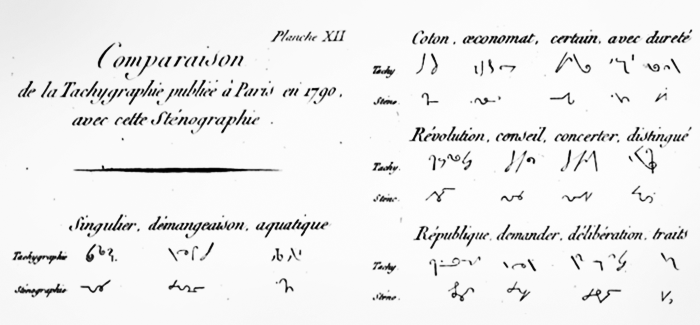
Excerpt from a table comparing stenography and tachygraphy from appendix to Système universel et complet de sténographie by Théodore-Pierre Bertin (1792). (Image courtesy Daniele Metilli)
A literary mystery hidden inside a 150-year-old copy of Homer’s Odyssey finds an answer.
An Italian computer engineer solved a 150-year-old literary mystery found in a rare edition of Homer’s Odyssey at the University of Chicago Library.
In 2007 the University received a donation of Homer’s works from collector M. C. Lang, including a 1504 Venetian edition of the Odyssey containing handwritten annotations in an unknown script. In hopes of cracking the code, this past spring the library’s Special Collections Research Center offered a $1,000 prize from Lang to the first person to identify the script, provide evidence to support the conclusion, and translate selected portions of the marginalia. Submissions poured in from around the world.
The winner of the contest, Daniele Metilli, was taking a digital humanities course and is aiming for a career in libraries and archives. Working with Giula Accetta, a colleague proficient in contemporary Italian stenography and fluent in French, Metilli identified the mystery script as a system of shorthand invented by Jean Coulon de Thévenot in the late 18th century. The annotations themselves are mostly French translations of words and phrases from the Greek text of the Odyssey.
Based on the mix of French words within the script and a legible date of April 25, 1854, Metilli and Accetta began with the assumption that it was a system of French stenography in use in the mid-19th century. After rejecting several such systems, they uncovered a chart comparing one of them to the tachygraphie (shorthand) system invented by Thévenot and published in Méthode tachygraphique, ou l’art d’écrire aussi vite que la parole (1789). Online, they found an 1819 edition revised by a professor of stenography, N. Patey. Then they began the work of translating the annotations. (The above left detail translates to “when a year will have made its turn.”)
In Thévenot’s system, “every consonant and vowel has a starting shape, and they combine together to form new shapes representing syllables,” Metilli wrote. “The vertical alignment is especially important, as the position of a letter above or below the line, or even the length of a letter segment can change the value of the grapheme. This explains why most notes in the Odyssey shorthand are underlined—the line being key to the transcription.”
Metilli and Accetta continue to work on the annotations and hope to identify their author and explain why they appear in only one section of the text.
